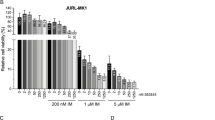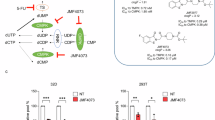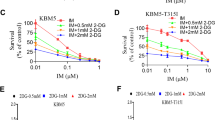Abstract
Aim:
To find new kinase inhibitors that overcome the imatinib resistance in treatment of chronic myeloid leukemia (CML), we synthesized C817, a novel derivative of curcumin, and tested its activities against wild-type (WT) and imatinib-resistant mutant Abl kinases, as well as in imatinib-sensitive and resistant CML cells in vitro.
Methods:
32D cells harboring WT or mutant Abl kinases (nucleotide binding P-loop mutants Q252H, Y253F, and imatinib contact residue mutant T315I), as well as K562/G01 cells (with whole Bcr-Abl gene amplication) were tested. Kinase activity was measured using Kinase-Glo Luminescent Kinase Assay Platform in recombinant WT and mutant (Q252H, Y253F, and T315I) Abl kinases. Cell proliferation and apoptosis were examined using MTT assay and flow cytometry, respectively. The phosphorylation levels of Bcr-Abl initiated signaling proteins were analyzed using Western blotting. Colony forming units (CFU) growth and long term culture-initiating cells (LTC-ICs) were used to test the effects of C817 on human leukemia progenitor/stem cells.
Results:
C817 potently inhibited both WT and mutant (Q252H, Y253F, and T315I) Abl kinase activities in a non-ATP competitive manner with the values of IC50 at low nanomole levels. In consistent with above results, C817 suppressed the growth of both imatinib-sensitive and resistant CML cells, including wild-type K562, K562/G01, 32D-T315I, 32D-Q252H, and 32D-Y253F cells with the values of IC50 at low micromole levels. C817 (0.5 or 1 μmol/L) dose-dependently inhibited the phosphorylation of Bcr-Abl and downstream proteins STAT-5 and CrkL in imatinib-resistant K562/G01 cells. Furthermore, C817 significantly suppressed CFU growth and LTC-ICs, implicating that C817 could eradiate human leukemia progenitor/stem cells.
Conclusion:
C817 is a promising compound for treatment of CML patients with Bcr-Abl kinase domain mutations that confer imatinib resistance.
Similar content being viewed by others
Log in or create a free account to read this content
Gain free access to this article, as well as selected content from this journal and more on nature.com
or
References
Druker BJ, Talpaz M, Resta DJ, Peng B, Buchdunger E, Ford JM, et al. Efficacy and safety of a specific inhibitor of the BCR-ABL tyrosine kinase in chronic myeloid leukemia. N Engl J Med 2001; 344: 1031–7.
Gorre ME, Mohammed M, Ellwood K, Hsu N, Paquette R, Rao PN, et al. Clinical resistance to STI-571 cancer therapy caused by BCR-ABL gene mutation or amplification. Science 2001; 293: 876–80.
von Bubnoff N, Schneller F, Peschel C, Duyster J . BCR-ABL gene mutations in relation to clinical resistance of Philadelphia-chromosome-positive leukaemia to STI571: a prospective study. Lancet 2002; 359: 487–91.
Perl A, Carroll M . BCR-ABL kinase is dead; long live the CML stem cell. J Clin Invest 2011; 121: 22–5.
Corbin AS, Agarwal A, Loriaux M, Cortes J, Deininger MW, Druker BJ . Human chronic myeloid leukemia stem cells are insensitive to imatinib despite inhibition of BCR-ABL activity. J Clin Invest 2011; 121: 396–409.
Larson RA, Hochhaus A, Hughes TP, Clark RE, Etienne G, Kim DW, et al. Nilotinib vs imatinib in patients with newly diagnosed Philadelphia chromosome-positive chronic myeloid leukemia in chronic phase: ENESTnd 3-year follow-up. Leukemia 2012; 26: 2197–203.
Saglio G, Kim DW, Issaragrisil S, Coutre P, Etienne G, Lobo C, et al. Nilotinib versus imatinib for newly diagnosed chronic myeloid leukemia. N Engl J Med 2010; 362: 2251–9.
Rosti G, Palandri F, Castagnetti F, Breccia M, Levato L, Gugliotta G, et al. Nilotinib for the frontline treatment of Ph(+) chronic myeloid leukemia. Blood 2009; 114: 4933–8.
O'Hare T, Walters DK, Stoffregen EP, Jia T, Manley PW, Mestan J, et al. In vitro activity of Bcr-Abl inhibitors AMN107 and BMS-354825 against clinically relevant imatinib-resistant Abl kinase domain mutants. Cancer Res 2005; 65: 4500–5.
Weisberg E, Manley PW, Breitenstein W, Bruggen J, Cowan-Jacob SW, Ray A, et al. Characterization of AMN107, a selective inhibitor of native and mutant Bcr-Abl. Cancer Cell 2005; 7: 129–41.
Redaelli S, Piazza R, Rostagno R, Magistroni V, Perini P, Marega M, et al. Activity of bosutinib, dasatinib, and nilotinib against 18 imatinib-resistant BCR/ABL mutants. J Clin Oncol 2009; 27: 469–71.
Cortes JE, Kantarjian H, Shah NP, Bixby D, Mauro MJ, Flinn I, et al. Ponatinib in refractory Philadelphia chromosome-positive leukemias. N Engl J Med 2012; 367: 2075–88.
Adrián FJ, Ding Q, Sim T, Velentza A, Sloan C, Liu Y, et al. Allosteric inhibitors of Bcr-abl-dependent cell proliferation. Nat Chem Biol 2006; 2: 95–102.
Zhang J, Adrián FJ, Jahnke W, Cowan-Jacob SW, Li AG, Iacob RE, et al. Targeting Bcr-Abl by combining allosteric with ATP-binding-site inhibitors. Nature 2010; 463: 501–6.
Adams BK, Ferstl EM, Davis MC, Herold M, Kurtkaya S, Camalier RF, et al. Synthesis and biological evaluation of novel curcumin analogs as anti-cancer and anti-angiogenesis agents. Bioorg Med Chem 2004; 12: 3871–83.
Liu Y, Xu JH, Li N, Zhang NW, Xu JH . Synthesis of 3,5-dibenzylidenepiperidin-4-one analogs and their antitumor activities in vitro. Chin J Med Chem 2011; 21: 262–6.
Luo H, Quan H, Xie C, Xu Y, Fu L, Lou L . HH-GV-678, a novel selective inhibitor of Bcr-Abl, outperforms imatinib and effectively overrides imatinib resistance. Leukemia 2010; 24: 1807–9.
Qi J, Peng H, Gu ZL, Liang ZQ, Yang CZ . Establishment of an imatinib resistant cell line K562/G01 and its characterization. Zhonghua Xue Ye Xue Za Zhi 2004; 25: 337–41.
Wu LX, Xu JH, Zhang KZ, Lin Q, Huang XW, Wen CX, et al. Disruption of the Bcr-Abl/Hsp90 protein complex: a possible mechanism to inhibit Bcr-Abl-positive human leukemic blasts by novobiocin. Leukemia 2008; 22: 1402–9.
van Os RP, Dethmers-Ausema B, de Haan G . In vitro assays for cobblestone area-forming cells, LTC-IC, and CFU-C. Methods Mol Biol 2008; 430: 143–57.
Meng A, Wang Y, Brown SA, Van ZG, Zhou D . Ionizing radiation and busulfan inhibit murine bone marrow cell hematopoietic function via apoptosis-dependent and -independent mechanisms. Exp Hematol 2003; 31: 1348–56.
Guan Y, Gerhard B, Hogge DE . Detection, isolation, and stimulation of quiescent primitive leukemic progenitor cells from patients with acute myeloid leukemia (AML). Blood 2003; 101: 3142–9.
Budak-Alpdogan T, Alpdogan O, Akoglu T . Morphological and functional characteristics of short-term and long-term bone marrow cultures in chronic myelogenous leukemia. Am J Hematol 1999; 62: 212–20.
Tretiakova I, Blaesius D, Maxia L, Wesselborg S, Schulze-Osthoff K, Cinatl J Jr, et al. Myrtucommulone from Myrtus communis induces apoptosis in cancer cells via the mitochondrial pathway involving caspase-9. Apoptosis 2008; 13: 119–31.
Tian Z, Shen J, Moseman AP, Yang Q, Yang J, Xiao P, et al. Dulxanthone A induces cell cycle arrest and apoptosis via up-regulation of p53 through mitochondrial pathway in HepG2 cells. Int J Cancer 2008; 122: 31–8.
Del BB, Valentini MA, Comporti M, Maellaro E . Cisplatin-induced apoptosis in melanoma cells: role of caspase-3 and caspase-7 in Apaf-1 proteolytic cleavage and in execution of the degradative phases. Ann N Y Acad Sci 2003; 1010: 200–4.
Troiano L, Ferraresi R, Lugli E, Nemes E, Roat E, Nasi M, et al. Multiparametric analysis of cells with different mitochondrial membrane potential during apoptosis by polychromatic flow cytometry. Nat Protoc 2007; 2: 2719–27.
Hassan AQ, Sharma SV, Warmuth M . Allosteric inhibition of BCR-ABL. Cell Cycle 2010; 9: 3710–4.
Jatiani SS, Cosenza SC, Reddy MV, Ha JH, Baker SJ, Samanta AK, et al. A non-ATP-competitive dual inhibitor of JAK2 and BCR-ABL kinases: Elucidation of a novel therapeutic spectrum based on substrate competitive inhibition. Genes Cancer 2010; 1: 331–45.
Weisberg E, Deng X, Choi HG, Barrett R, Adamia S, Ray A, et al. Beneficial effects of combining a type II ATP competitive inhibitor with an allosteric competitive inhibitor of BCR-ABL for the treatment of imatinib-sensitive and imatinib-resistant CML. Leukemia 2010; 24: 1375–8.
Fabbro D, Manley PW, Jahnke W, Liebetanz J, Szyttenholm A, Fendrich G, et al. Inhibitors of the Abl kinase directed at either the ATP- or myristate-binding site. Biochim Biophys Acta 2010; 1804: 454–62.
Passegue E, Wagner EF, Weissman IL . JunB deficiency leads to a myeloproliferative disorder arising from hematopoietic stem cells. Cell 2004; 119: 431–43.
Passegue E, Jamieson CH, Ailles LE, Weissman IL . Normal and leukemic hematopoiesis: are leukemias a stem cell disorder or a reacquisition of stem cell characteristics? Proc Natl Acad Sci U S A 2003; 100: 11842–9.
Acknowledgements
We gratefully acknowledge the National Natural Science Foundation of China (30901824, 81173096, 81273541, 30873101, and 30472187), National Science and Technology Foundation of China for Key Projects of “Major New Drugs Innovation and Development” (2012ZX09103-101-028), the Natural Science Foundation of Fujian Province of China (Outstanding project 2011J06013), and the Educational Bureau of Fujian Province of China (JA11101) for this project.
Author information
Authors and Affiliations
Corresponding authors
Rights and permissions
About this article
Cite this article
Wu, Lx., Wu, Y., Chen, Rj. et al. Curcumin derivative C817 inhibits proliferation of imatinib-resistant chronic myeloid leukemia cells with wild-type or mutant Bcr-Abl in vitro. Acta Pharmacol Sin 35, 401–409 (2014). https://doi.org/10.1038/aps.2013.180
Received:
Accepted:
Published:
Issue date:
DOI: https://doi.org/10.1038/aps.2013.180



